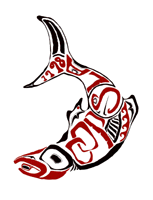 OOPSLA'98
Business Object Workshop IV
OOPSLA'98
Business Object Workshop IV OOPSLA'98
Business Object Workshop IV
OOPSLA'98
Business Object Workshop IVPavel Hruby
Navision Software a/s
Frydenlunds Allé 6
2950 Vedbęk, Denmark
Tel.: +45 45 65 50 00
Fax: +45 45 65 50 01
E-mail: ph@navision.com
Web: http://www.navision.com, then click
"services"
The PDF version of this paper is on the address http://www.navision.com/default.asp?url=services/methodology/default.asp.
Unified Modeling Language (UML) defines a standard notation for object-oriented systems. Using UML enhances communication between domain experts, workflow specialists, software designers and other professionals with different backgrounds. UML can be used on a general level, which is intuitive for the users of workflow systems. In spite of this, UML symbols also have defined semantics, which means that the visual workflow description can be used as a software specification. This position paper explains how to use UML for specification of workflow management systems, how to trace the description of business processes to the object-oriented software design and how to structure the project repository with UML deliverables.
This paper is organized in the following way. This, the first section, explains the need for a common language among software designers and users of the workflow products. The second section shows how to represent common workflow concepts in Unified Modeling Language (UML). The third section outlines how to connect the description of the workflow system with the object-oriented software specification.
The following scenario can often depict the implementation of a new workflow management system in a corporation: a consultant works together with the users to describe the corporate business processes to be supported by a software solution. The team of developers receives the consultant's description, but they have trouble understanding the business terminology and find the description too informal to use for implementing the system. The developers write their own system specification from a technical point of view. When the system specification is presented to the users, they do not quite understand it because it is too technical. They are, however, forced to accept it in order to move forward.
This approach can easily result in a system that does not meet the requirements of the users because often the users, the consultants and the developers don't speak the same language. Such communication problems can make it difficult to turn a description of business processes into a technical software specification that all parties can understand. In addition, because a technical system specification that is not fully understood by the actual users of the system is used, software system becomes difficult to use.
The challenge is to model business processes and business systems in a way that is both precise and user-friendly. Each symbol describing a business process should be intuitive for the user and have defined semantics, so that the developers can use the description as a general, but precise specification of the software system.
UML is rich and complicated notation for describing software systems. The notation is perhaps too rich to be intuitive and user-friendly. However, UML has two advantages, which make it suitable for representing workflow management systems. First, UML is the generally accepted notational standard in the software community and second, UML can be used on a general level, where implementation details are suppressed. The UML diagrams shown in the next section are very similar to those that domain experts are already using intuitively. Moreover, their semantics are defined precisely. The same diagrams can be adorned with implementation details for software design purposes, if necessary.
The description of business systems consists of a description of processes and static structures. The most intuitive model of a process is a sequence of activities or tasks, performed in order to achieve a goal [1]. Therefore, the UML sequence diagram and the UML activity diagram are suitable for a user-friendly, yet precise, specification of business processes. Static structures, such as an organizational chart, can be represented by UML static structure diagrams without implementation details. Graphical representation of implementation details is often misleading for non-UML experts, for example, navigation arrows are often mistaken for flows. It is advisable to use only a certain subset of UML representation options. For example, it is better to show compositions by placing elements inside each other, rather than by using associations with filled diamonds. Various properties can be represented by text, rather than by UML symbols, for example, the text «refine » is easier to understand than a dashed line with a triangular arrow.
This section includes examples of workflow concepts represented in UML. The purpose of this section is only to give a general guideline on how to map workflow common concepts to UML because the details are easy to derive from UML Semantics and Notation Guide [7]. Every construct of workflow management systems can be depicted by a UML symbol with an appropriate stereotype.
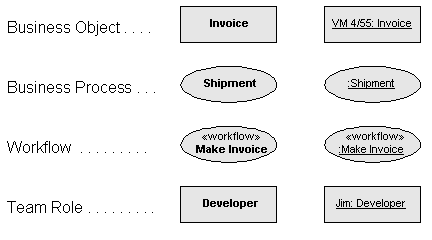
Fig. 1 Representation of a business object, a business process and a team role in UML.
Fig. 1 shows examples of representation of business processes, business objects and team roles in UML. Business objects are represented by classes and objects in UML. Classes represent business objects without identity, such as an invoice. Objects represent business objects, which have identity, such as the invoice with the number VM 4/55. Business processes are represented by use cases and use case instances. The use cases are definitions of business processes in terms of goals, responsibilities, preconditions and postconditions. The use case instances are concrete sequences of events. Workflows are automated business processes. They are represented as use cases or use case instances with a stereotype «workflow». Team roles are represented by classes and objects in UML. Classes represent types of team roles, objects represent concrete workers playing the role. All the symbols can be adorned with an appropriate stereotype, such as «business object», «business process» and «team role». Each stereotype can be represented either by text or by a specific icon.
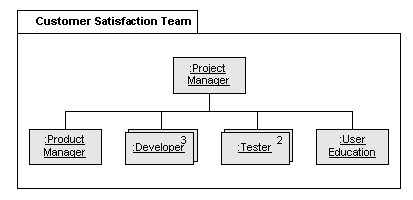
Fig. 2 UML static structure diagram representing a team structure.
Fig. 2 shows an example of a team structure. The team roles are represented as object instances, which allows for specifying the number of workers in each role. The customer satisfaction team has three developers, two testers, one product manager and one person in the user education role. The group of roles, called the customer satisfaction team, is represented by the package symbol. The group of roles might also be represented as an object – as a composition of roles. If the team is represented as an object and the relationships between the team and the roles are composition relationships, then, according to the UML metamodel, a specific role instance cannot be part of more than one team at the same time. If the team is represented as a package, a specific role instance can be a part of several teams at the same time.
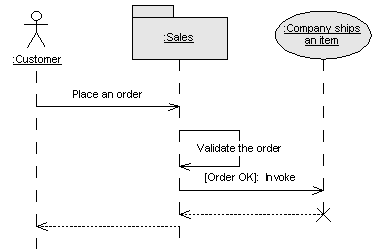
Fig. 3 UML sequence diagram representing the instance of the business process
Fig. 3 represents the instance of the business process. The actor customer places an order, and then an unspecified worker in the sales department validates the order. If the order is valid, the worker in sales invokes an instance of another business process company ships an item. This type of diagram is not explicitly mentioned in the UML Notation Guide. However, it conforms to the UML metamodel. The symbols at the top of the object lifelines represent classifier roles, which in Fig. 3 are the actor role, the object role and the use case role.
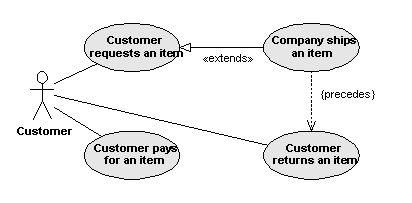
Fig. 4 UML use case diagram representing static relationships between business processes
Fig. 4 is the UML use case diagram, representing static relationships between business processes. The business processes describe collaborations of the organization with the actor customer. Please note that in UML version 1.1, use cases cannot communicate with each other and they are always started by a signal from the actor. This leads to difficulties in modeling situations in which a use case is started during execution of another use case when a specific condition is met. In such situations, use cases are initiated by the actor through communication with another use case and not by any specific starting signal from the actor. For example, the use case company ships an item is started by an object inside the organization if the customer’s request has been evaluated as valid. This use case instance is not directly started by the customer. I hope that the next version of UML will weaken this restriction about communications between use cases.
The UML use case diagram cannot easily represent the order of use case instances, for example, that first the customer requests an item, then the company ships the item and finally, the customer pays for the item. One of the solutions is to use constraints {precedes} or dependencies «precedes» between use cases. Similar relationships exist in OML (OPEN modeling language), see reference [3]. Robert C. Martin suggested to use the keyword follows instead of the precedes, please see reference [6]. The reason for this replacement is that the dependency «follows» points in the opposite direction to the dependency «precedes». The dependency «follows» points in the direction usual for the dependency – from the dependent element to the independent element. Which one is more intuitive is an open question. However, the diagram with constraints or dependencies is still a static structure diagram and does not represent a scenario.
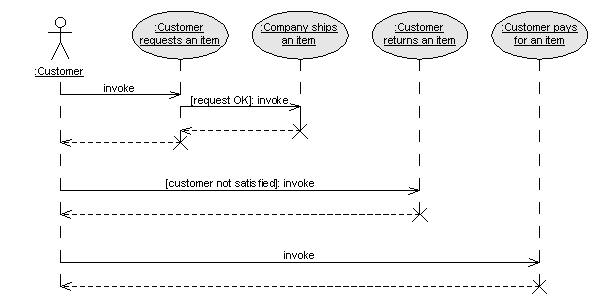
Fig. 5 UML sequence diagram represents interactions between business processes and actors.
An actor can use a system in a way that initiates use cases in a particular order. Such a scenario – a sequence of use case instances – can be represented by use case sequence or collaboration diagrams, see Figs. 5 and 6. In contrast to object interaction diagrams, where a scenario is described as a sequence of messages, the use case interaction diagram describes the scenario as a sequence of use cases. This diagram is the only UML diagram that can describe a scenario consisting of instances of other scenarios. The messages invoke in Fig. 5 represent constructors of the use cases and they map to the signals from the actors to the use cases. They can also be named according to the first operation in each use case, such as invoke request, invoke shipment and invoke payment. Except for these messages, the use case interaction diagram can show other messages exchanged between the actor and the system and describe complete conversations between use case and actor.
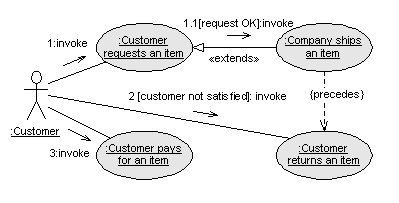
Fig. 6 UML collaboration diagram represents interactions and relationships between business processes and actors.
The use case collaboration diagram also represents a scenario consisting of instances of business processes. Unlike the use case sequence diagram, the use case collaboration diagram shows both use case relationships and messages exchanged between use case instances and actor instances. The use case collaboration diagram is illustrated in Fig. 6.
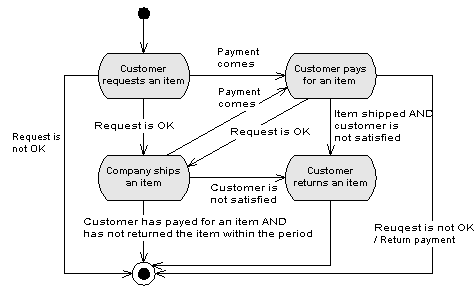
Fig. 7 UML activity diagram can represent allowable order of business processes
The use case interaction diagrams describe only typical scenarios consisting of use case instances. Therefore, they cannot represent all allowable sequences of use case instances. The allowable order of use case instances belonging to a use case package can be specified in the lifecycle of the use case package. The lifecycle of the use case package is represented by a state diagram, activity diagram of Backus-Naur form (BNF), in which states, action states or BNF statements map to the use cases of the use case package. The use case package lifecycle is a precise representation of the use case package behavior. It can, however, be difficult to develop it correctly, especially in complex cases. The use case interaction diagram is easy to develop, but it describes only typical scenarios consisting of use cases in the package.
Fig 7 represents the UML activity diagram representing the lifecycle of the use case package order management. The activities on this activity diagram correspond to the use cases discussed in Figs 4, 5 and 6.
Please note that the UML metamodel does not define any mapping from states or action states to use case instances. Such mapping might be defined by the development process, similar to the approach by Martin and Odell, in which states of the subsystem indicate candidate classes in the subsystem, see reference [5]. However, other development processes might define the semantics of the use case package lifecycle in a different way. For example, the purpose of the use case package lifecycle might be to specify the allowable order of subsystem interface operations in the scope of the use case package.
There is one more significant difference between the use case interaction model and the use case lifecycle – their placement in the project repository is different and their relationships to other design artifacts are different. The artifact use case interaction model is related to the artifact use case model. The artifact use case package lifecycle is related to the artifact use case package, which is one level of abstraction higher than the corresponding use case model and use case interaction model. Please see Fig. 8 and the next section for details.
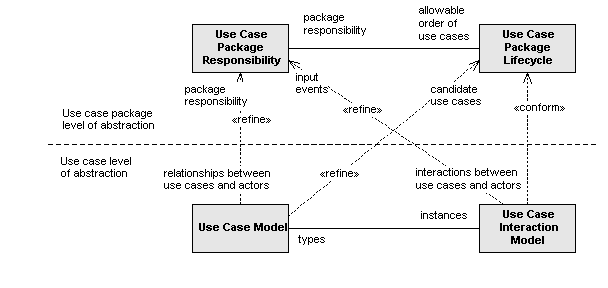
Fig. 8 Relationship between artifacts in the use case view in the project repository. The notation is modified UML. For better clarity, dependencies were adorned by role ends.
During the development process, software architects, designers and developers identify certain information about the software product. Examples of such information are the use cases, the software architecture, the object collaborations and the class descriptions. The information can be very abstract, such as the vision of the product, or very concrete, such as the source code. In this paper, I call such pieces of information about the software product design artifacts.
We must realize that there is a difference between a design artifact and its representation. The design artifact determines the information about the business system, and the representation determines how the information is presented. Some design artifacts are represented in UML, and some are represented by text or by tables. For example, the class lifecycle can be represented by a UML statechart diagram, an activity diagram, state transition table or in Backus-Naur form. The object interactions can be represented by UML sequence diagrams or by UML collaboration diagrams. The class responsibility is represented by text.
A useful specification of a business system is based on precisely defined design artifacts, rather than on diagrams. This section and the following section discuss a structure of the design artifacts, which provides clear tracing of information describing business processes, business rules, a software architecture and a design of the business system. The structure can easily be extended to cover other aspects of the business system, such as the team structure and the project planning.
Business systems can be described at various levels of abstraction and in various views. Some examples of levels of abstraction are the organizational level, the system level, the architectural level and the class level. Some examples of views are the logical view, the use case view, the analysis view, the testing view or the use documentation view. At each level of abstraction and in each view, the software product can be described by four design artifacts: static relationships between classifiers, dynamic interactions between classifiers, classifier responsibilities and classifier lifecycles. Each of these artifacts can be represented by UML diagrams or by text. The pattern is illustrated in Figs. 9 and 10. Please see reference [3] for more information about applications of the pattern to other aspects of software design, such as the testing, database design, user interface and user documentation aspects.
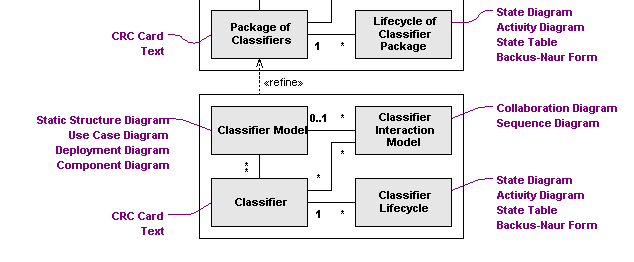
Fig. 9 The pattern of design artifacts for structuring project repositories.
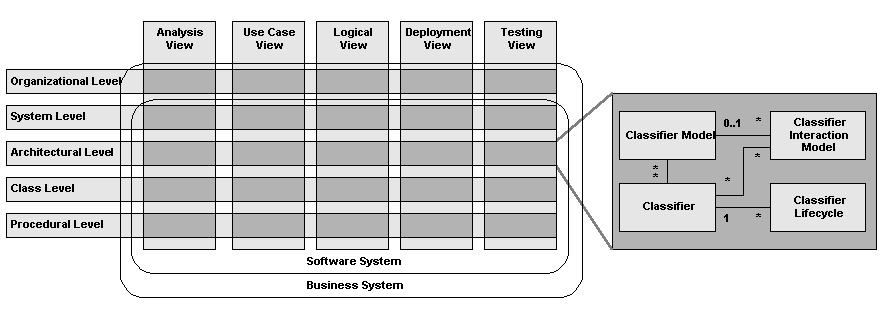
Fig. 10 At each level of abstraction and in each view, the software product can be described by four design artifacts. UML classifiers are class, interface, use case, node, subsystem and component.
The classifier model specifies static relationships between classifiers. The classifier model can be represented by a set of static structure diagrams (if classifiers are subsystems, classes or interfaces), a set of use case diagrams (if classifiers are use cases and actors), a set of deployment diagrams (if classifiers are nodes) and a set of component diagrams in their type form (if classifiers are components).
The classifier interaction model specifies interactions between classifiers. The classifier interaction model can be represented by interaction diagrams: sequence diagrams or collaboration diagrams. The UML Notation Guide describes only interaction diagrams in which classifiers are objects; it does not describe interaction diagrams in which classifiers are use cases, subsystems, nodes or components.
The design artifact called classifier specifies classifier responsibilities, roles, and static properties of classifier interfaces (for example, a list of classifier operations with preconditions and postconditions). Classifiers can be represented by structured text, for example, in the form of a CRC card.
The classifier lifecycle specifies classifier state machine and dynamic properties of classifier interfaces (for example, the allowable order operations and events). The classifier lifecycle can be represented by a statechart diagram, an activity diagram and a state transition table.
An instance of the classifier model can be linked to several instances of the classifier interaction model. All of these instances are linked to instances of the classifier. An instance of the classifier is linked to an instance of the classifier lifecycle.
In well-structured design specification, the required information about business processes and software products can be easily located and closely related information is linked together. The structure should also give an overview about the completeness and consistency between design artifacts. The specification should act as common ground between business experts, consultants and software developers. The structure should also support clear separation of concerns, so that business people - and not the developers - define all business rules. This section identifies relationships between business processes and software design artifacts, which can be used for structuring the project repository. This section gives a guideline for structuring information about business processes and about their relationships to software design artifacts. Please see reference [4] for concrete examples of the repository structures.
The structure is based on the assumption that business processes (represented as use cases in UML) are collaborations between business objects, actors, workers or other instances in a business system. I assume that definitions of business processes (use cases) are types of collaborations, specifying the collaboration responsibility, goal, precondition, postcondition and system operations involved in the collaboration. Business process instances (use case instances) are instances of collaborations, specifying concrete sequences of actions and events, system states and state transitions during the collaboration.
Fig. 11 shows relationships between design artifacts specifying business processes and logical design of the software system. Artifacts are structured according to the level of abstraction: the organizational level, the system level, the architectural level and the object level.
The organizational level specifies the responsibility of an organization (such as a company, school, or government body) and the business context of the organization. The artifact organization specifies responsibility and relevant static properties of the organization. The artifact organization model specifies relationships of the organization to other organizations. The artifact organization use case specifies the business process with the organizational scope in terms of the process goal, precondition, postcondition, business rules that the process must meet and other relevant static properties of the process. This business process is a collaboration of the organization with other organizations. All collaborations of the organization with other organizations are described in the artifact organization use case model, see the dependency «collaborations» in Fig. 11. The instances of organization business processes are specified in the artifact organization interaction model in terms of the interactions of the organization with other organizations. The organization business processes can be refined into more concrete system business processes, see the dependency «refine» in Fig. 11. Allowable order of the system business processes is specified in the artifact organization use case life cycle. The organization use case interaction model specifies typical sequences of business process instances, see the dependency «instance» in Fig. 11. The realization of the organizational business process is specified by the interactions between the software system and its users (team roles) see the dependency «realize» in Figs. 11 and 12.
The system level specifies the context of the software system and its relationships to its actors. The artifact system specifies the system interface, the system operations with responsibilities, preconditions, postconditions, parameters and return values. The artifact actor specifies the actor responsibilities and interfaces, if they are relevant. The system lifecycle specifies the allowable order of system operations and events. The system model specifies relationships between the software system and actors (other systems or users), and the system interaction model specifies interactions between the software system and actors. These interactions are instances of system business processes, see the dependency «instance» in Fig. 11. The artifact system use case specifies the business process with the system scope in terms of the process goal, precondition, postcondition, the non-functional requirements of the process, business rules and other relevant static properties. This business process is a collaboration of the system with other systems and users. All collaborations of the system with its actors are described in the artifact system use case model, see the dependency «collaborations» in Fig. 11. The dynamic properties of the business process interface, such as the allowable order of system operations in the scope of the business process, are specified in the system use case life cycle. The system use case interaction model specifies typical sequences of business process instances. The system business processes can be refined into subsystem business processes, see the dependency «refine» in Fig. 11. The realization of the system business process is specified by the interactions between subsystems at the architectural level, see the dependency «realize» in Fig. 11.
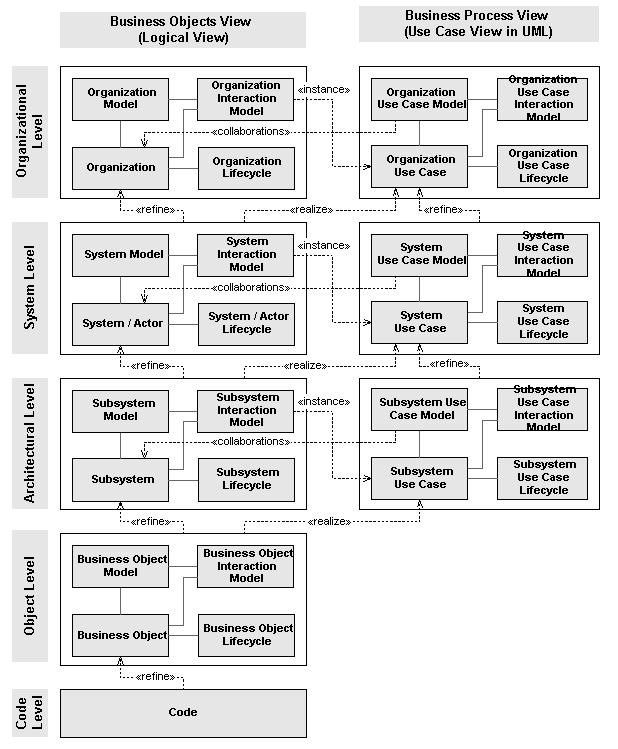
Fig. 11 Design artifacts describing the software system in the logical and business process views.
The architectural level defines subsystems (components), their responsibilities, interfaces, relationships and interactions. The artifact subsystem specifies the subsystem interface, the subsystem operations with responsibilities, preconditions, postconditions, parameters and return values. The subsystem lifecycle specifies the allowable order of subsystem operations and events. The subsystem model specifies relationships between the subsystem and other subsystems, and the subsystem interaction model specifies interactions between the subsystem and other subsystems. These interactions are instances of subsystem business processes, see the dependency «instance» in Fig. 11. The artifact subsystem use case specifies the business process with the subsystem scope. This business process is a collaboration of the subsystem with other subsystems, systems and users. All collaborations of the subsystem with is actors are described in the artifact subsystem use case model, see the dependency «collaborations» in Fig. 11. The dynamic properties of the subsystem business process interface, such as the allowable order of subsystem operations in the scope of the business process, are specified in the subsystem use case life cycle. The subsystem use case interaction model specifies typical sequences of business process instances. The realization of the subsystem business process is specified by interactions between objects at the class level, see the dependency «realize» in Fig. 11.
The object level provides details about the design of the subsystem in terms of the business objects, their responsibilities, relationships and interactions. The business object model specifies static relationships between business objects. The business object interaction model specifies the design of subsystem operations in terms of interactions between business objects. The artifact business object specifies the business object responsibility and the static properties of business object interfaces, such as the interface operations with preconditions and postconditions. The business object lifecycle specifies the allowable order of interface operations.
Fig. 12 shows design artifacts describing the team structure of the organization. In fact there is no significant difference between the structure of artifacts describing a software subsystem and the structure of artifacts describing a team. Roles of team members can be shown as stereotyped classes in UML. The artifact role specifies responsibilities of the worker role and other relevant static properties of the role. The artifact role lifecycle specifies dynamic properties of roles, their states and to which events they respond. The artifact role model specifies static relationships between roles. The member level business process specifies collaborations of the team member role with other team member roles, see the dependency «collaborations» in Fig. 12. The instances of these business processes are specified in the artifact role interaction model in terms of interactions between role instances, see the dependency «instance» in Fig. 12.
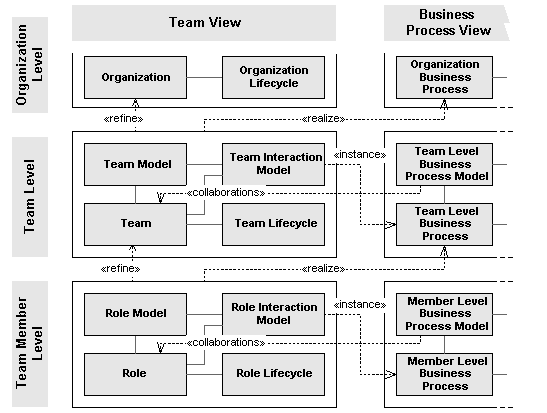
Fig. 12 Design artifacts describing the software system in the team and business process views.
The design artifact called team is a package of roles. The team specifies the responsibility of the team and relevant static properties of the team. Dynamic properties of the team are specified in the artifact team life cycle. The artifact team model specifies static relationships between teams. The team level business process specifies collaborations of the team with other teams, see the dependency «collaborations» in Fig. 12. Instances of the team level business processes are specified in the artifact team interaction model, see the dependency «instance» in Fig. 12. The realizations of the team level business processes are specified by interactions of the team members and by interactions of the team members with the software system, see the dependency «realize» in Fig. 12. The pattern of design artifacts can be applied at the higher levels of abstraction in a similar way to that shown above.
The structure of design artifacts described in this section can be simplified in two ways:
Using a subset of design artifacts may not lead to the loss of information because the UML system of diagrams is not orthogonal. This means that the same information can be specified in two or more different UML diagrams. For example, both the static structure diagram and the object collaboration diagram specify relationships between objects. Both statecharts and interaction diagrams specify messages between objects. Because the same information can be specified in several places, developers can produce only a certain subset of design artifacts, or the artifacts must be checked for consistency.
For pragmatic reasons, designers can create larger deliverables containing several closely related artifacts. For example, classifier responsibilities and lifecycles are always related to and can be joined into one document. It is also possible to combine organizational, system, subsystem and class use case diagrams into one large use case diagram, providing that use case levels are clearly distinguished. Similarly, system, subsystem and business object static structure diagrams and corresponding interaction diagrams at all levels can be joined into one document. It is also compatible with UML semantics to join the static structure diagrams, the component, node and use case diagrams within each level. In this way designers can show static relationships between use cases, actors, subsystems, business objects, team members and business processes in one large static structure diagram, although the UML notation guide does not explicitly mention such a combined static structure diagram.
Please see reference [4] for details on how to simplify the structure of design artifacts described in this section.
This paper discussed the representation of business systems in UML, with an emphasis on workflow management systems. The paper described mapping between typical business concepts and UML concepts and suggested the structure of design artifacts for tracing the information between definitions of business processes and the object-oriented software design. The structure assumes that business processes can be considered as collaborations between business objects, team roles and other instances in a business system. The structure is based on a pattern of four mutually related design artifacts that represent classifier relationships, interactions, responsibilities and lifecycles. The pattern was applied at different levels of abstraction and in different views on a business system. The pattern can be applied to specify various other aspects of the design of business and software systems.
[1] Alexander, I, A.: A Co-Operative Task Modeling Approach to Business Process Understanding, workshop on Object-Oriented Business Process Modeling, ECOOP 98, Brussels, Belgium, July 20-24, 1998, also available at http://www.scenarioplus.com/talk/approach_to_task_modelling.html and at http://www.ibissoft.se/oocontr/alexander.htm
[2] Cockburn, A.: Using Goal-Based Use Cases, Journal of Object Oriented Programming, November 1997, also available at http://members.aol.com/acockburn/papers/usecases.htm
[3] Henderson-Sellers, B, Graham, I., The OPEN Modeling Language (OML) Reference Manual, SIGS Books, NY, 1997, available at http://www.csse.swin.edu.au/cotar/OPEN/OPEN.html
[4] Hruby, P.: Structuring Design Deliverables with UML, <<UML>>’98, Mulhouse, France, June 3-4 1998. also available at http://www.navision.com/default.asp?url=services/methodology/default.asp
[5] Martin, J., Odell, J. J.: Object-Oriented Methods: a Foundation. Prentice Hall, Inc. 1998
[6] Martin, R. C.: RE: RE: (OTUG) use cases: abstract and concrete (<<precedes>>), Mailing list OTUG, available at http://www.rational.com/HyperMail/otug/hypermail/9807/0195.html
[7] UML Notation Guide, version 1.1, Rational, 1 September 1997, also at http://www.rational.com/uml
[8] Stark, H., Lachal, L.: Ovum Evaluates Workflow, Ovum Ltd. 1995.
 OOPSLA'98
Business Object Workshop IV
OOPSLA'98
Business Object Workshop IV